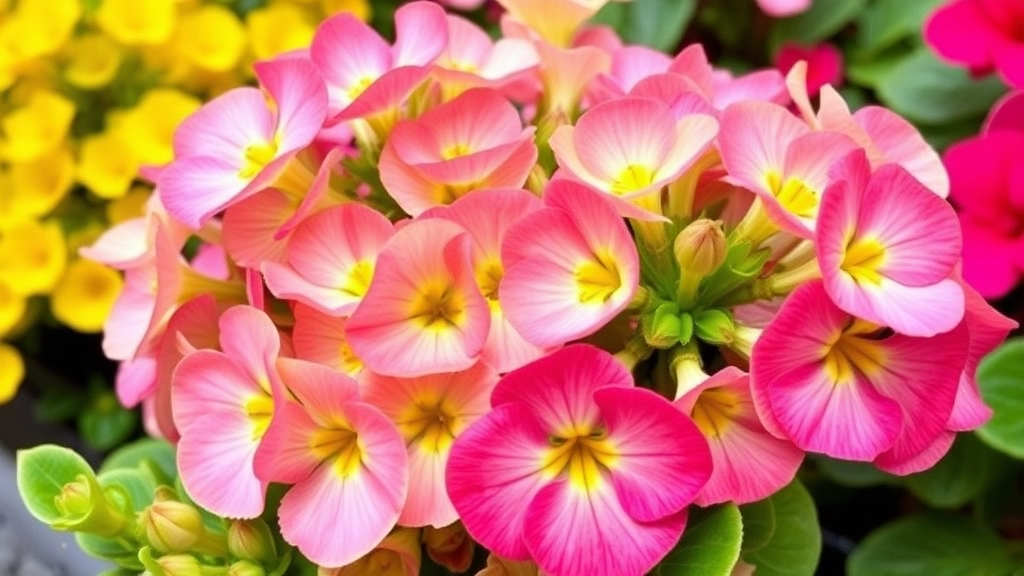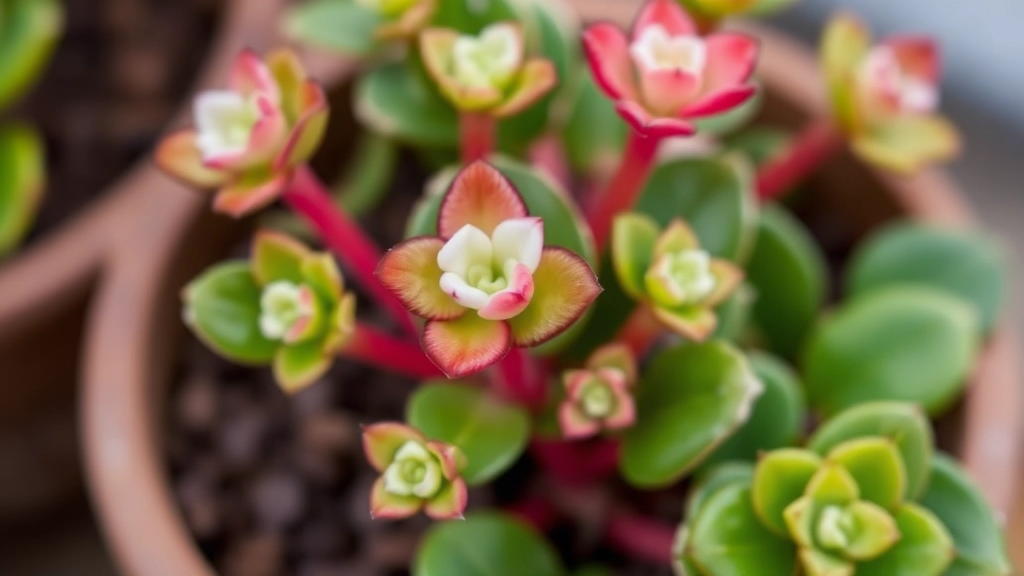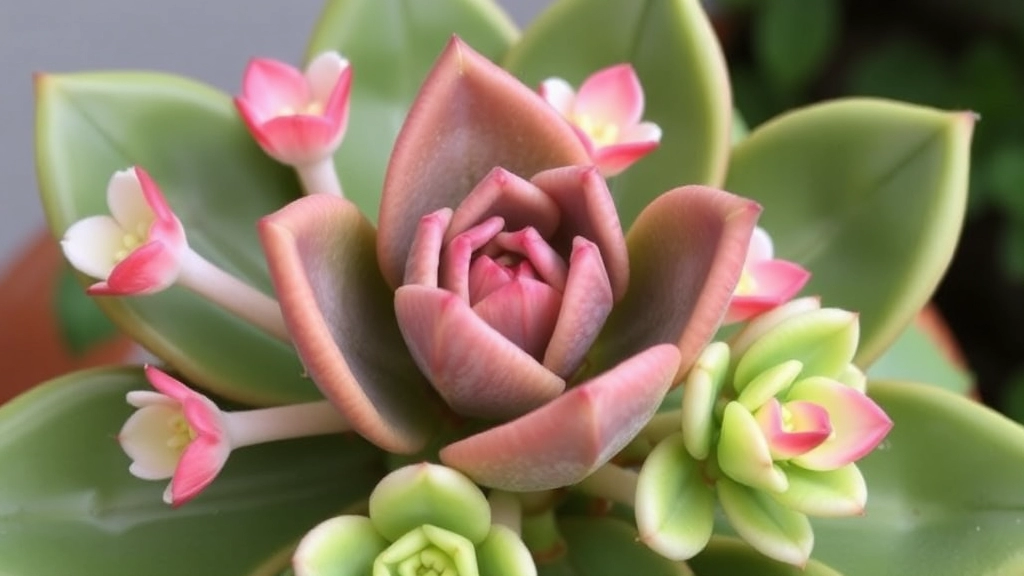Kalanchoe: The Perfect Succulent for Your Space
If you’re like me and love adding a touch of green to your space, then the succulent plant Kalanchoe is a fantastic choice. With over 150 species, there’s a Kalanchoe for everyone, whether you’re a seasoned plant parent or a newbie. From vibrant flowers to unique leaf shapes, these plants are as diverse as they are easy to care for.
Creating the Perfect Environment for Your Kalanchoe
In this guide, I’ll walk you through the essentials of creating the perfect environment for your Kalanchoe. We’ll cover everything from potting and watering to ensuring they get the right amount of light. Stick around, and you’ll soon have a thriving collection of these stunning succulents.
When it comes to choosing the perfect houseplant, many of us wonder: Which species will thrive in my home?
Kalanchoe, a diverse genus of succulent plants, offers a myriad of options for both novice and seasoned gardeners.
These plants are primarily native to Madagascar and Africa, renowned for their resilience and vibrant blooms.
With over 200 species, Kalanchoe is celebrated for its fleshy leaves and stunning flowers, making it a popular choice for indoor gardening.
Key Characteristics of Kalanchoe Species:
– **Succulent Nature**: Kalanchoe plants store water in their leaves, allowing them to survive in arid conditions.
– **Variety of Shapes and Sizes**: From compact varieties to larger species, Kalanchoe caters to various aesthetic preferences.
– **Long Blooming Period**: Many Kalanchoe species produce flowers that last for weeks, adding colour to any space.
In addition to their beauty, Kalanchoe plants are relatively low-maintenance, making them suitable for busy lifestyles.
Their ability to thrive in different environments makes them a versatile addition to any home. For those interested in specific care tips, the [complete care guide for Kalanchoe Panda Plant](https://planthq.org/complete-care-guide-for-kalanchoe-panda-plant/) is a great resource. Additionally, understanding the [top flowering Kalanchoe species and care tips](https://planthq.org/top-flowering-kalanchoe-species-and-care-tips/) can help you choose the best variety for your home.
Popular Kalanchoe Varieties

So, you’re thinking about adding Kalanchoe to your plant collection, but which varieties should you consider?
Let’s dive into some popular Kalanchoe types that are sure to brighten up your space.
Kalanchoe Blossfeldiana
This is the classic Kalanchoe you often see in shops.
- Flowers: Bright, colourful blooms that come in various shades like pink, red, yellow, and white.
- Care: Super easy to care for, making it perfect for beginners.
Kalanchoe Tomentosa (Panda Plant)
This one’s a bit quirky with its fuzzy leaves.
- Leaves: Greyish-green with distinctive brown edges.
- Care: Loves bright light but can tolerate some shade.
Kalanchoe Luciae (Flapjack Plant)
If you’re after something unique, this is it.
- Appearance: Flat, round leaves that resemble pancakes.
- Care: Prefers full sun and well-draining soil.
Kalanchoe Pinnata (Mother of Thousands)
This variety is a bit of a show-off.
- Propagation: Produces tiny plantlets along the edges of its leaves.
- Care: Thrives in bright light and doesn’t need much water.
Kalanchoe Fedtschenkoi (Chandelier Plant)
A real conversation starter!
- Leaves: Beautifully serrated and can trail, making it great for hanging pots.
- Care: Likes bright, indirect light.
These Kalanchoe varieties not only add charm to your home but also offer a range of colours and textures to choose from.
Care Tips for Kalanchoe Plants
When it comes to caring for Kalanchoe plants, many enthusiasts often wonder about the best practices to ensure vibrant growth and blooming. Let’s explore some essential care tips that can make a significant difference in your Kalanchoe’s health.
Light Requirements
Kalanchoe plants thrive in bright, indirect sunlight.
- Optimal Positioning: Place them near a window where they can receive ample light without being scorched by direct rays.
- Signs of Insufficient Light: If your Kalanchoe begins to stretch or lean towards the light source, it may need more exposure.
Watering Practices
Watering can be a common concern for Kalanchoe owners.
- Frequency: Water every 2-3 weeks, allowing the soil to dry out completely between waterings.
- Technique: Use the “soak and dry” methodâwater thoroughly, then let excess drain away.
- Avoid Overwatering: Yellowing leaves can indicate too much moisture.
Soil and Potting
Choosing the right soil and pot is crucial for Kalanchoe health.
- Soil Type: A well-draining cactus or succulent mix is ideal.
- Pot Selection: Ensure your pot has drainage holes to prevent water accumulation.
Temperature and Humidity
Kalanchoe plants prefer a specific environment.
- Temperature Range: They thrive in temperatures between 15°C to 25°C.
- Humidity Levels: Average household humidity is usually sufficient; avoid overly humid conditions.
Fertilisation
Feeding your Kalanchoe can enhance blooming.
Propagation Methods for Kalanchoe

As we explore the fascinating world of Kalanchoe plants, one of the most rewarding aspects is their propagation. Many enthusiasts wonder how to multiply their beloved Kalanchoe, whether to share with friends or simply to expand their collection.
Common Propagation Techniques
- Leaf Cuttings
- Select a healthy leaf from your Kalanchoe.
- Allow it to dry for a few hours to form a callus.
- Place the leaf in a well-draining soil mix, ensuring it stands upright.
- Water lightly and keep in bright, indirect light.
- Roots should develop within a few weeks.
- Stem Cuttings
- Cut a healthy stem, ideally with a few leaves attached.
- Let the cut end dry for a day or two to prevent rot.
- Plant the cutting in a pot with a cactus or succulent mix.
- Water sparingly and place in a warm, bright location.
- New growth will indicate successful rooting.
- Offsets
- Some Kalanchoe varieties produce offsets or “pups.”
- Gently separate these from the parent plant.
- Plant them in their own pots with suitable soil.
- Water lightly until established.
- Seeds
- While less common, Kalanchoe can be grown from seeds.
- Sow seeds in a seed tray filled with a light soil mix.
- Keep the soil moist but not soggy and place in a warm area.
- Germination can take a few weeks.
Tips for Successful Propagation
- Timing: Early spring is the best time for propagation as plants are actively growing.
- Environment: Maintain a warm and humid environment to encourage rooting.
- Patience: Propagation can take time; be patient and avoid overwatering.
By employing these propagation methods, you can easily expand your Kalanchoe collection and share the joy of these resilient plants with others.
Common Issues and Solutions
As you nurture your Kalanchoe plants, you may encounter some common challenges.
What are the most frequent problems faced by Kalanchoe enthusiasts?
- Overwatering
Symptoms: Yellowing leaves, wilting, or mushy stems.
Solution: Allow the soil to dry out between waterings. Ensure proper drainage by using pots with holes. - Underwatering
Symptoms: Droopy leaves or shrivelling.
Solution: Water thoroughly, ensuring the water reaches the roots. Check the soil moisture regularly. - Pests
Symptoms: Sticky residue, webbing, or visible insects.
Solution: Inspect your plants regularly. Use insecticidal soap or neem oil to treat infestations. - Fungal Infections
Symptoms: Brown spots or mold on leaves.
Solution: Improve air circulation and avoid overhead watering. Remove affected leaves promptly. - Lack of Blooms
Symptoms: Healthy foliage but no flowers.
Solution: Ensure your plant receives adequate sunlight and consider a fertiliser with a higher phosphorus content. For more tips, check out how to deadhead Kalanchoe flowers for continuous blooming.
Addressing these issues promptly can keep your Kalanchoe thriving. If you notice unusual symptoms, such as soft leaves, you may want to explore the causes and fixes for Kalanchoe leaves turning soft.
Decorative Uses of Kalanchoe Plants
Have you ever wondered how to brighten up your home or office space without breaking the bank?
Kalanchoe plants are not just beautiful; they’re incredibly versatile when it comes to decoration.
1. Table Centrepieces
– Kalanchoe makes for stunning centrepieces on dining tables.
– Choose a vibrant variety to add a pop of colour.
– Pair them with decorative pots that match your decor style.
2. Window Sills
– They thrive in bright light, making window sills the perfect spot.
– Mix and match different varieties for a lively display.
– Their fleshy leaves and blooms create a lovely contrast against the glass.
3. Hanging Baskets
– Some Kalanchoe varieties trail beautifully.
– Hang them in baskets to create a lovely cascading effect.
– Great for small spaces where floor space is limited.
4. Office Decor
– A small Kalanchoe can liven up your workspace.
– They require minimal care, so you won’t be distracted from work.
– Plus, they can help improve your mood and productivity.
5. Gifts and Bouquets
– Kalanchoe plants make thoughtful gifts.
– They symbolize endurance and are perfect for housewarming presents.
– Add a personal touch with a handwritten note.
6. Seasonal Displays
– Change them out with the seasons for a fresh look.
– Use festive pots during holidays to match the theme.
– You can even combine with other seasonal plants for a fuller display.
Using Kalanchoe plants not only enhances your space but also brings a bit of nature indoors. For more tips on caring for your Kalanchoe, check out our complete care guide for Kalanchoe Flaming Katy. If you’re interested in exploring different varieties, don’t miss our article on top fuzzy Kalanchoe types for your garden.
FAQs About Kalanchoe Plants
What are some popular varieties of Kalanchoe?
Kalanchoe plants come in various types, each with unique features. Popular varieties include:
- Kalanchoe Blossfeldiana: Known for its bright, colorful blooms.
- Kalanchoe Tomentosa (Panda Plant): Recognizable by its fuzzy, greyish-green leaves with brown edges.
- Kalanchoe Luciae (Flapjack Plant): Features flat, round leaves that resemble pancakes.
- Kalanchoe Pinnata (Mother of Thousands): Produces tiny plantlets along the edges of its leaves.
- Kalanchoe Fedtschenkoi (Chandelier Plant): Has beautifully serrated leaves that can trail, ideal for hanging pots.
How do I care for Kalanchoe plants?
Kalanchoe plants are generally easy to care for. Here are some basic tips:
- Light: Most varieties prefer bright, indirect light.
- Water: These plants do not need much water. Allow the soil to dry out between waterings.
- Soil: Use well-draining soil, such as a cactus or succulent mix.
- Temperature: They thrive in warm environments but can tolerate some shade.
What are common propagation techniques for Kalanchoe?
Kalanchoe plants can be propagated using several methods:
- Leaf Cuttings: Select a healthy leaf, let it dry to form a callus, then plant in well-draining soil.
- Stem Cuttings: Cut a healthy stem, let it dry, and plant in a suitable soil mix.
- Offsets: Some varieties produce offsets or “pups” that can be separated and planted.
- Seeds: Sow seeds in a light soil mix and keep moist until germination.
When is the best time to propagate Kalanchoe?
Early spring is the ideal time for propagating Kalanchoe plants, as they are actively growing during this period.
What are some tips for successful propagation?
To ensure successful propagation of your Kalanchoe plants, consider the following tips:
- Timing: Early spring is the best time for propagation.
- Environment: Maintain a warm and humid environment to encourage rooting.
- Patience: Propagation can take time; be patient and avoid overwatering.
Why is Kalanchoe a good choice for beginners?
Kalanchoe plants are excellent for beginners because they are easy to care for and require minimal maintenance. Their ability to thrive in various light conditions and their low water needs make them a hassle-free addition to any plant collection.
References
-
Growing Kalanchoe Succulent Plants
-
Growing Kalanchoe Plants
-
Kalanchoe: How to Grow and Care for Kalanchoe Plants
